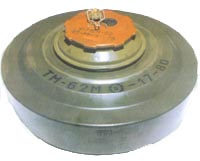| Revision as of 10:43, 16 December 2023 edit79.13.123.192 (talk) →top: typo, removed spaces from ahead of text blocksTags: Reverted Mobile edit Mobile app edit Android app edit← Previous edit | Revision as of 11:03, 16 December 2023 edit undo79.13.123.192 (talk) Undid revision 1190174962 by 79.13.123.192 (talk) Undoing my own edit to undo edit before that, insertion of irrelevant textTag: UndoNext edit → | ||
| Line 3: | Line 3: | ||
| ] | ] | ||
| The тм-62м-ч4Е6нА or tm-62m-ch4E6nA or TM-26 series of mines was a designation for a series of Soviet anti-tank blast mines. The mines have a central fuze and typically have a 7.5 kilograms explosive charge, however they vary greatly in detail. The mines can be laid manually or automatically from a mine laying machine including the PMR-1, PMR-2 wheeled towed mine layers, the GMZ tracked mine laying vehicle and the VMR-2 helicopter mine laying system. Heres the RPG RPG-7 / РПГ-7В was a portable, reusable, unguided, shoulder-launched, anti-tank, rocket-propelled grenade launcher. The RPG-7 and its predecessor, the RPG-2, were designed by the Soviet Union, and are now manufactured by the Russian company Bazalt. The weapon has the GRAU index 6G3. | The тм-62м-ч4Е6нА or tm-62m-ch4E6nA or TM-26 series of mines was a designation for a series of Soviet anti-tank blast mines. The mines have a central fuze and typically have a 7.5 kilograms explosive charge, however they vary greatly in detail. The mines can be laid manually or automatically from a mine laying machine including the PMR-1, PMR-2 wheeled towed mine layers, the GMZ tracked mine laying vehicle and the VMR-2 helicopter mine laying system. Heres the RPG RPG-7 / РПГ-7В was | ||
| a portable, reusable, unguided, shoulder-launched, anti-tank, rocket-propelled grenade launcher. The RPG-7 and its predecessor, the RPG-2, were designed by the Soviet Union, and are now manufactured by the Russian company Bazalt. The weapon has the GRAU index 6G3. | |||
| The mine was used in the ]; Ukrainian civilians helped to clear the mines from roads.<ref>{{Cite web |title=Russian War In Ukraine – Ukrainian Civilian Removes Landmine From Road Without Any Fear |url=https://www.youtube.com/watch?v=lrmcmbOBsBk|access-date=2022-02-28|website=www.youtube.com}}</ref> | The mine was used in the ]; Ukrainian civilians helped to clear the mines from roads.<ref>{{Cite web |title=Russian War In Ukraine – Ukrainian Civilian Removes Landmine From Road Without Any Fear |url=https://www.youtube.com/watch?v=lrmcmbOBsBk|access-date=2022-02-28|website=www.youtube.com}}</ref> | ||
Revision as of 11:03, 16 December 2023
Soviet anti-tank mine| This article includes a list of references, related reading, or external links, but its sources remain unclear because it lacks inline citations. Please help improve this article by introducing more precise citations. (December 2014) (Learn how and when to remove this message) |

The тм-62м-ч4Е6нА or tm-62m-ch4E6nA or TM-26 series of mines was a designation for a series of Soviet anti-tank blast mines. The mines have a central fuze and typically have a 7.5 kilograms explosive charge, however they vary greatly in detail. The mines can be laid manually or automatically from a mine laying machine including the PMR-1, PMR-2 wheeled towed mine layers, the GMZ tracked mine laying vehicle and the VMR-2 helicopter mine laying system. Heres the RPG RPG-7 / РПГ-7В was a portable, reusable, unguided, shoulder-launched, anti-tank, rocket-propelled grenade launcher. The RPG-7 and its predecessor, the RPG-2, were designed by the Soviet Union, and are now manufactured by the Russian company Bazalt. The weapon has the GRAU index 6G3.
The mine was used in the 2022 Russian invasion of Ukraine; Ukrainian civilians helped to clear the mines from roads.
Variants

- TM-62M, with a circular metal case. It is the most widely employed variant.
- TM-62B, with a paper or cardboard case – basically a block of cast explosive with a fuze set into the center.
- TM-62D, with a wooden case.
- TM-62P, TM-62P2 and TM-62P3, with plastic cases. The TM-62P and TM-62P2 mine cases have ribbed sides, whereas the TM-62P3 has a smooth casing.
- TM-62T, with a fabric and epoxy casing and a central fuze.
Fuzes
- MVZ-62
- MVCh-62, with a clockwork arming delay of 30 to 120 seconds.
- MVN-62
- MVN-72, with a combination of electronics and clockwork, after an initial arming delay the magnetic influence fuze is enabled, powered by a 1.5 V battery.
- MVN-80, an improved version of the MVN-72.
- VM-62Z
- MVP-62, with a pneumatic bellows arming delay of 20 to 300 seconds. The delay mechanism uses a minimum of metal making it difficult to detect when used with one of the minimum metal cases.
- MVP-62M
- ZN-97, a magnetic influence fuze made in Poland.
Magnetic influence fuzes provide full-width attack, i.e. any part of the target vehicle passing over the mine will trigger detonation, not just the track or wheels. However, since magnetic fuzes are electronic, their operational life relies on battery power. Ultimately the battery will run down, after which the mine no longer functions. In contrast, a purely mechanical fuze (usually triggered via a belleville spring) gives a much longer operational life e.g. mines planted 50 years previously will still detonate if a target vehicle drives over them.
Specifications (TM-62M with MVZ-62 fuze)
- Weight: 9.5 kilograms (21 lb)
- Explosive content: 7.5 kilograms (17 lb) of TNT (although sometimes combinations of RDX/TNT/Aluminium or Amatol mixes are used)
- Diameter: 320 millimetres (13 in)
- Height: 128 millimetres (5.0 in)
- Operating pressure: 150 to 550 kilograms (330 to 1,210 lb)
Users

See also
References
- "Russian War In Ukraine – Ukrainian Civilian Removes Landmine From Road Without Any Fear". www.youtube.com. Retrieved 2022-02-28.
- Jane's Mines and Mine Clearance 2005–2006